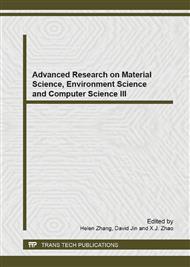[1]
P. Van de Witte, P.J. Dijkstra, J.W.A. Van den Berg, et al. Phase separation processes in polymer solutions in relation to membrane formation, J. Membr. Sci. 117(1996) 1-31.
DOI: 10.1016/0376-7388(96)00088-9
Google Scholar
[2]
A. Bottino, G. Camera-Roda, G. Capannelli, The formation of microporous polyvinylidene difluoride membranes by phase separation. J. Membr. Sci. 57(1991) 1-20.
DOI: 10.1016/s0376-7388(00)81159-x
Google Scholar
[3]
X. Zhang, Y. Chen, A.H. Konsowa, Evaluation of an innovative polyvinyl chloride (PVC) ultrafiltration membrane for wastewater treatment, Sep. Purif. Technol. 70(2009) 71-78.
DOI: 10.1016/j.seppur.2009.08.019
Google Scholar
[4]
S. Hirose, A. Shimizu, T. Nose, Preparation and structures of the poly (vinyl chloride) porous membranes, J. Appl. Polym. Sci. 23 (1979) 3193.
DOI: 10.1002/app.1979.070231105
Google Scholar
[5]
S. Hirose, E. Yasukawa, poly (vinyl chloride) membranes, J. Appl. Polym. Sci. 26 (1981) 1039.
Google Scholar
[6]
M. Bodzek, K. Konieczny, The influence of molecular mass of poly (vinyl chloride) on the structure and transport char-acteristics of ultrafiltration membranes, J. Membr. Sci. 61(1991) 131.
DOI: 10.1016/0376-7388(91)80011-t
Google Scholar
[7]
J. Xu, Z.L. Xu, Poly (vinyl chloride) (PVC) hollow fiber ultrafiltration membranes prepared from PVC/additives/solvent, J. Membr. Sci. 208 (2002) 203-212.
DOI: 10.1016/s0376-7388(02)00261-2
Google Scholar
[8]
M. Khayet, F.A. Qusay, Structural and performance studies of poly (vinyl chloride) hollow fiber membranes prepared at different air gap lengths, J. Membr. Sci. 330(2009) 30-39.
DOI: 10.1016/j.memsci.2008.12.020
Google Scholar
[9]
Y.R. Qiu, H. Matsuyama, Preparation and characterization of poly (vinyl butyral) hollow fiber membrane via thermally induced phase separation with diluent polyethylene glycol 200, Desalination 257(2010) 117-123.
DOI: 10.1016/j.desal.2010.02.036
Google Scholar
[10]
B.F.K. Kingsbury, K. Li, A morphological study of ceramic hollow fibre membranes, J. Membr. Sci. 328(2009) 134-140.
Google Scholar
[11]
K. Li, X. Tan, Y. Liu, Single-step fabrication of ceramic hollow fibers for oxygen permeation, J. Membr. Sci. 272(2006) 1-5.
Google Scholar
[12]
B.F.K. Kingsbury, K. Li, A morphological study of ceramic hollow fibre membranes, J. Membr. Sci. 328(2009) 134-140.
Google Scholar



